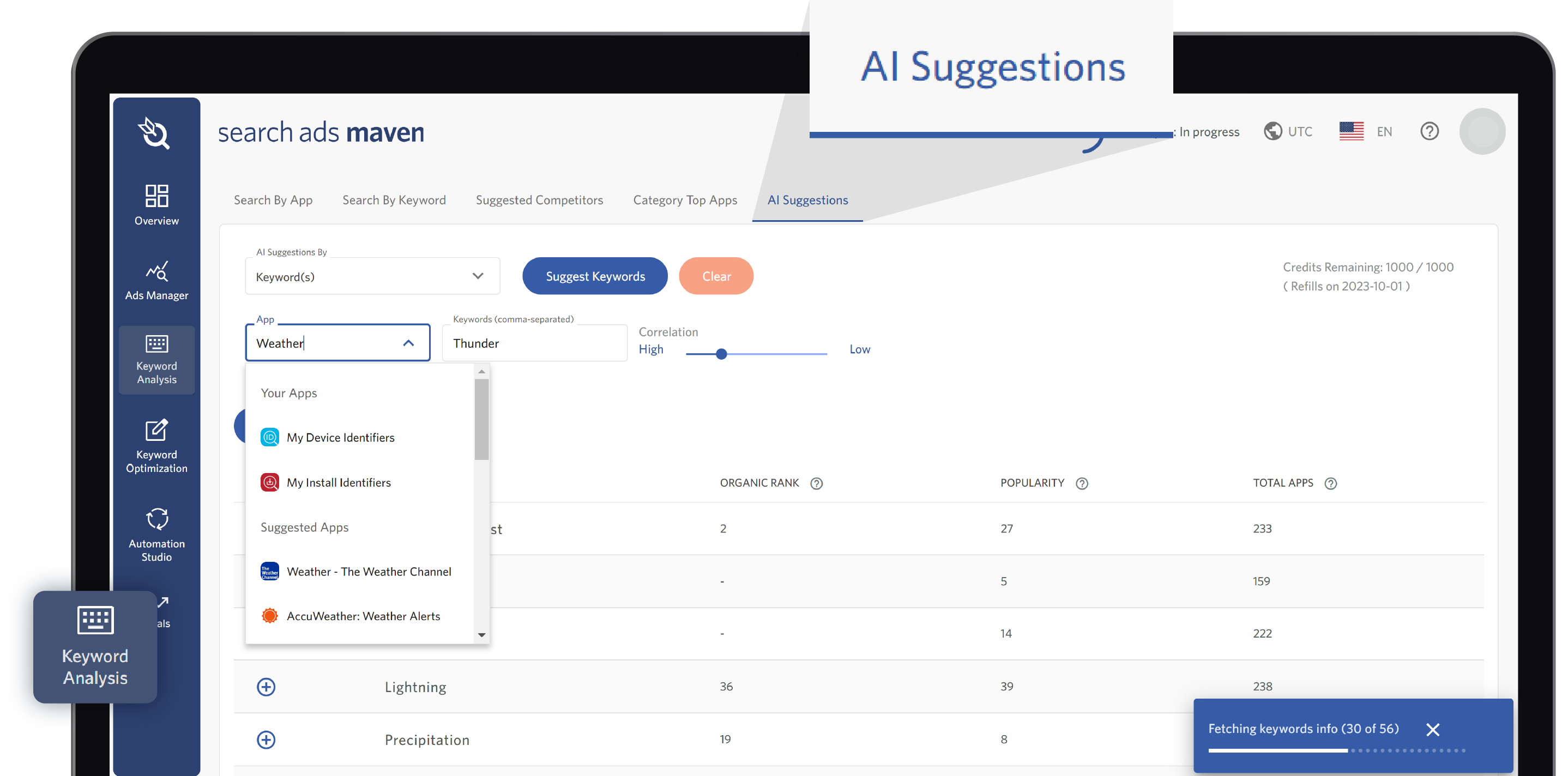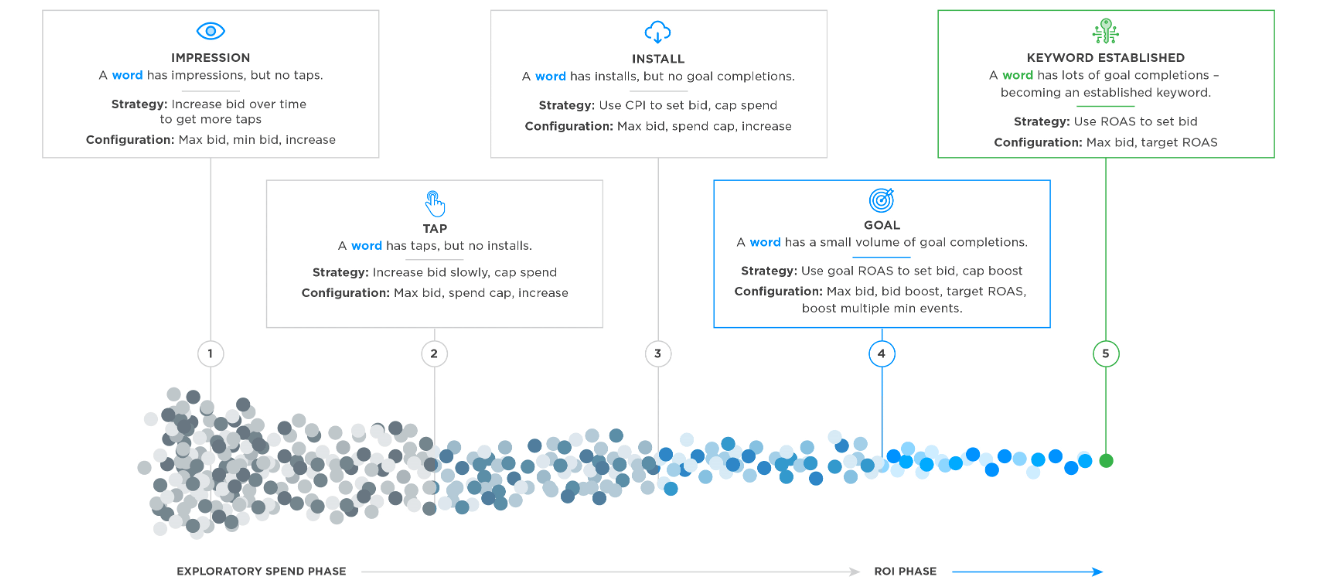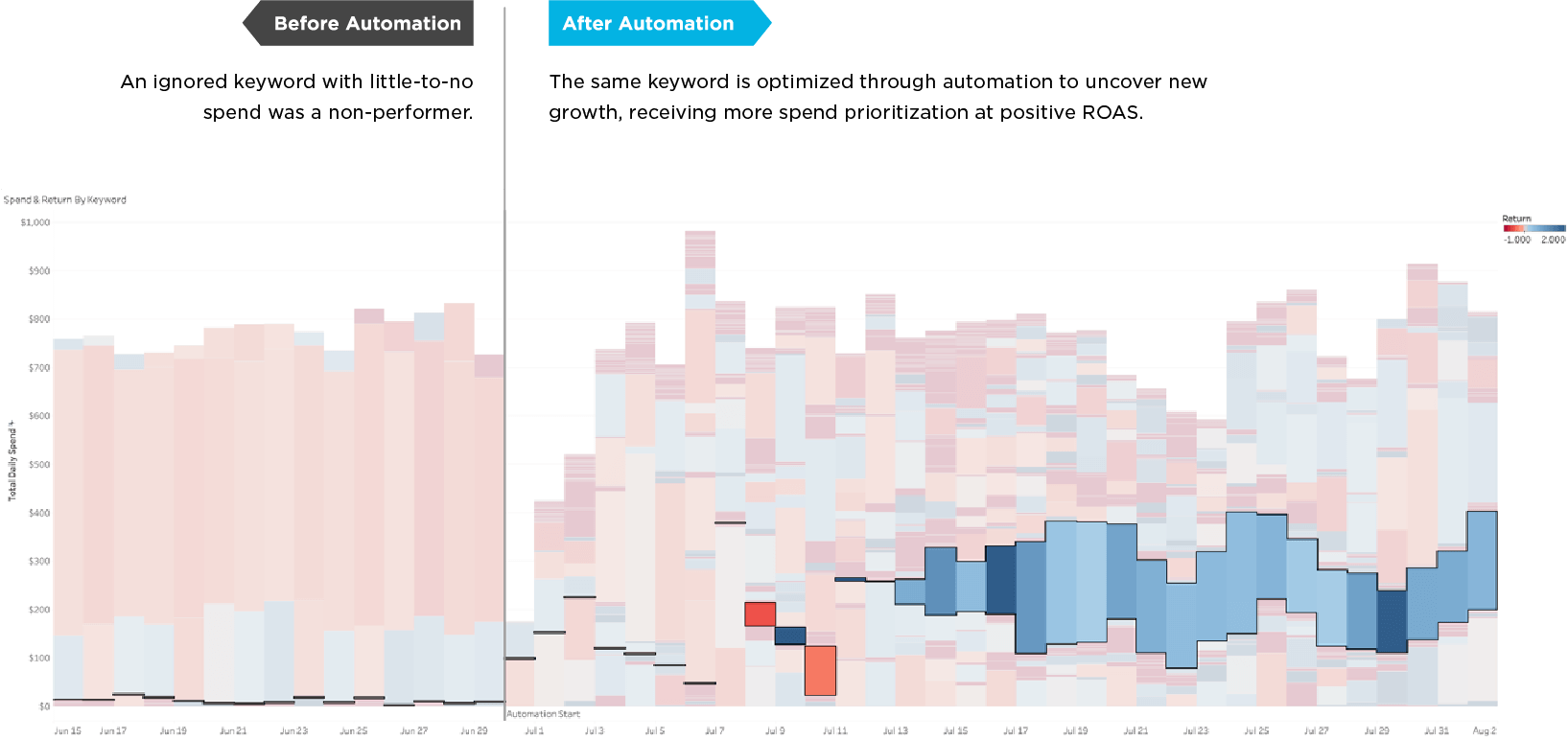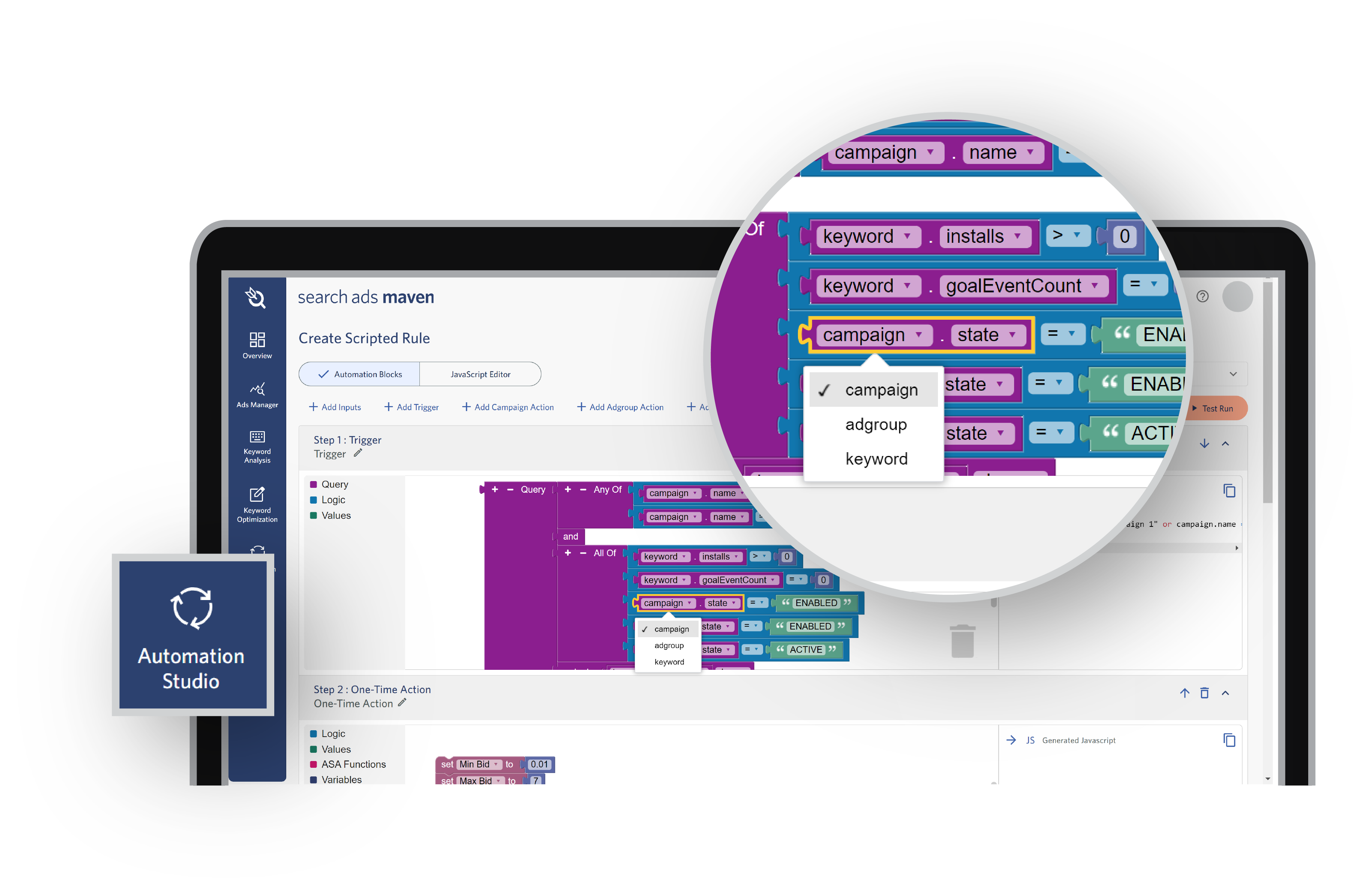Tapping into automation & AI to discover and test new keywords on Apple Search Ads
How many keywords are you bidding on for your Apple Search Ads (ASA) campaigns? If your answer is 10—even 50—or fewer, you’re leaving a lot of potential untapped. In this post, we’ll unpack why having more keywords is important and how to go about finding them efficiently and effectively.
Incorporating more keywords into your ASA bidding strategy has myriad benefits, including:
- Increasing visibility: Bidding on a wider range of keywords gives your ads a higher chance of appearing in relevant search results, expanding your reach and increasing the visibility of your app.
- Weathering bidding wars: Having a diverse set of keywords to bid on safeguards your budget from wildly fluctuating return on ad spend whenever competition on your routine keywords heats up.
- Targeting specific user intent: Having more keywords enables you to better target specific user intent and capture a broader range of potential customers, as users may enter a wide variety of search terms to find apps or products similar to yours.
- Besting your competitors: Bidding on more keywords allows you to outperform competitors who target a more limited set of keywords, giving you an advantage in reaching users who search for apps or products in your niche.
- Discovering new opportunities: Bidding on a wider range of keywords may reveal new search terms and user behavior patterns, potentially uncovering untapped markets, niche audiences, and areas for growth.
- Optimizing performance: Bidding on more keywords yields valuable data on which ones are driving the most conversions and engagement, helping you optimize campaigns, effectively allocate budgets, and refine overall keyword strategy.
While some brands have the resources to manage hundreds or even thousands of keywords spanning different global markets, most brands will certainly find it difficult, if not impossible, to reach that level.
Enter Automation and AI
The promise of automation and generative AI is changing the script for how marketers approach and manage Apple Search Ads. Marketers now have the ability to test large cohorts of new keywords, manage bid adjustments automatically, and tailor optimization logic based on target cost per acquisition (CPA) or cost per goal (CPG)—thereby ensuring that their keyword discovery process doesn’t break their budget.
Let’s look at what scaling and diversifying your keyword mix can achieve when leveraging always-on automation and AI.
Keyword Research and Discovery on Apple Search Ads
To discover new, diverse keywords for your campaigns, you should always start with research. Begin by defining your audience. Who are your ideal users? What keywords might they use to find apps like yours? Apple Search Ads keyword suggestion tools can help you identify relevant and high-traffic keywords.
Next, analyze competitors and research their keywords. You can gain insights by reviewing their app descriptions and titles, as well as the keywords they bid on.
A third-party campaign management tool such as Search Ads Maven powered by Kochava can speed up the keyword research and discovery process using keyword intelligence tools and suggestions from generative AI. AI helps you think outside of the box to uncover additional keywords your standard sources aren’t turning up.

Within the Search Ads Maven Keyword Analysis dashboard, marketers can generate AI keyword suggestions based on:
- Keyword(s): Enables you to find additional keywords similar to a keyword or keyword list that’s already on your radar.
- App Features: Enables you to find keywords based on your app’s features or those of similar apps with a relevant audience to your own.
- Language and Country: Enables you to find ideal keywords for a language and country you’re hoping to drive growth in, but may not be familiar with.
Once you have a list of new keywords, you can either pick and choose individual keywords to add to your campaign or bulk add the entire list. Now comes the process of testing the keywords to determine which will actually perform and facilitate your growth goals.
Testing and Proving Out New Keywords
Efficiently testing a considerable volume of newfound keywords can be overwhelming when managed manually. Any marketer who has tried this knows how many levers have to be pulled and how much time it takes. You’ll need to add the new keywords into various campaigns and ad groups, set initial minimum and maximum bids, manually monitor performance, make bid adjustments, and ensure that you don’t blow your budget on a keyword that proves a dud. Here is where automation can be a marketer’s best friend.
Within Search Ads Maven, marketers can utilize Keyword Optimization Journey. This tool templatizes a five-phase process that drives exploratory spend toward new keywords to gain enough traffic volume to gauge performance potential. The following diagram shows how the automation logic auto-adjusts your bidding strategy to achieve impressions, then gain taps, installs, and post-install goal completions. Only keywords that successfully make it to the final phase become established and automatically incorporated into your dedicated campaigns.

Ongoing Keyword Optimization
Continually optimizing your keyword bidding strategy across existing and newly added keywords can be even more time consuming than hunting down new ones. As market forces change, so does keyword performance, and it is challenging to monitor and respond fast enough to stay ahead. All too often, you find yourself reacting to missteps and wasted spend that you glimpse in the rearview mirror. Unfortunately, by that point the damage to your budget is already done, and windows of opportunity have passed. Employing always-on automation, however, gives your ASA campaigns, ad groups, and keyword bids the power to react hourly to changing conditions that are impossible to keep up with otherwise.
Let’s look at a real-world success story leveraging automation.
The following graph displays the keyword mix of an e-commerce app on the App Store before and after leveraging automation through Search Ads Maven. Each colored box within a bar represents a distinct keyword, with the height proportional to the volume of total spend for that day. The red hues indicate a return on ad spend (ROAS) that is less than 1 for the spend (the darker the red, the worse the ROAS). Blue hues indicate ROAS larger than 1 (the darker the blue, the better the ROAS).
Left of the divider line, depicting the time before automation was deployed, all the app’s spend is confined to only a small volume of keywords, many of which are underperforming—some driving significantly negative ROAS. Right of the line, the app has activated a cohort of new keywords into the Keyword Optimization Journey, while also using automation rules to optimize existing keywords.

Notice the significant increase in the mix of keywords as illustrated by the many different blocks in each bar on the right. With ongoing optimization, underperformers are quickly identified and removed from bidding, while strong pockets of positive ROAS emerge for both pre-existing and new keywords.
Turning Negative Keywords Positive
Breaking down the results even further, let’s look at a specific keyword that was consuming most of the brand’s spend prior to automation. The left side of the following graph shows this keyword taking the majority of spend, yet resulting in moderate-to-severe underperformance. The right side shows the same keyword’s performance post-automation, now producing peaks of positive ROAS with far less spend.

Investing in Long-Tail, Ignored Keywords
In this final graph, an ignored keyword with little to no spend clearly performs poorly while managed manually by the app’s marketing team. Once automation is applied, the same keyword comes to life and reveals its potential, earning more spend prioritization and driving highly positive ROAS.

Always-On Automation Is Key on Apple Search Ads
Automation is key when it comes to diversifying and optimizing your keyword bidding strategy on ASA. The team at Search Ads Maven leverages a built-in Automation Studio to help customers build an automation strategy with fully transparent logic based on each customer’s goals and KPIs.
Embrace automation to eliminate the hassle of laborious, hands-on campaign management, gain transparency, and save precious time. With the hours saved, you can break free from the muddy trenches and focus on strategic thinking that propels success.

Test Out Automation
If you’re interested in a free test of Apple Search Ads automation tools or want more information on diversifying your keywords, request a demo of Search Ads Maven or contact us at support@searchadsmaven.com.

